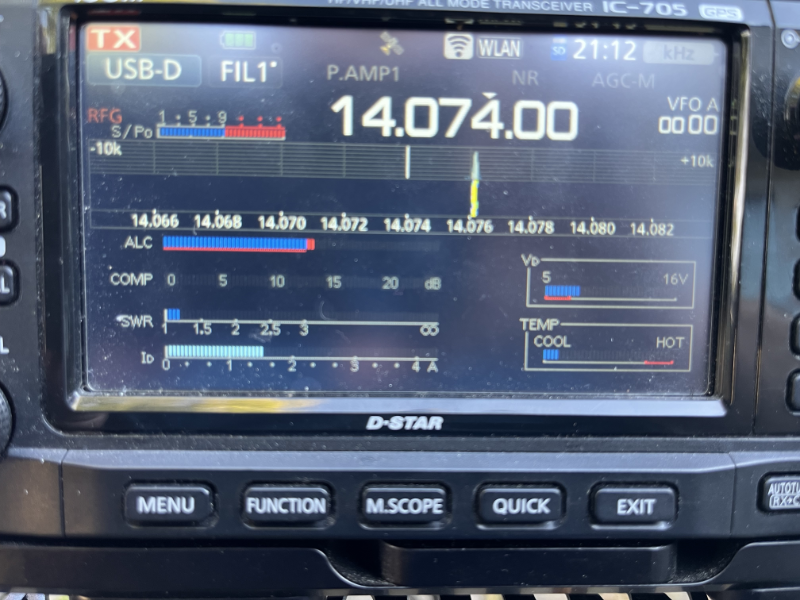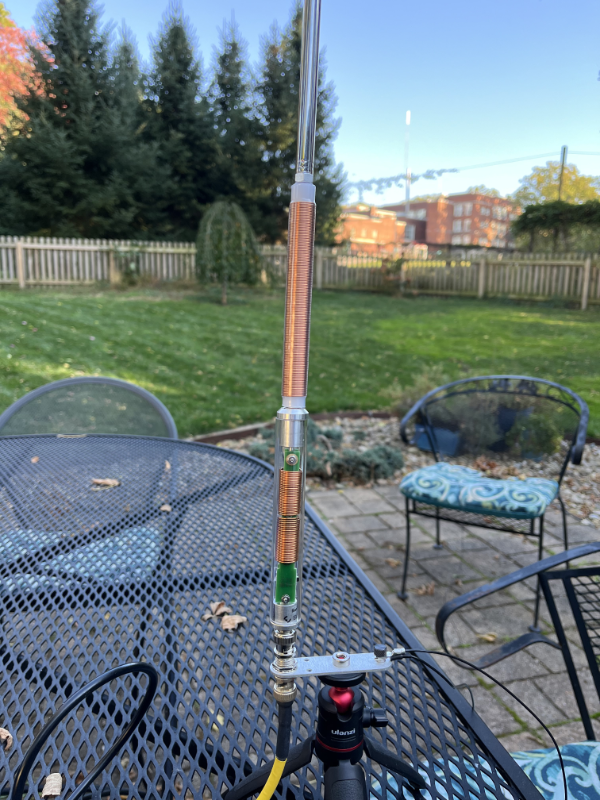Ah That Beautiful Autumn Weather
It’s that time of the year where Northeast Ohio reminds us that it’s going to be cold and miserable for a bit. There was a good amount of rain on Saturday and that combined with a myriad of family activities made getting out for an activation impossible. Sunday was a new day and a different story. Sort of. There was still a concert to attend and the weather was still promising cold and wind, but there was enough time in the morning to get out to the park and rack up 10 contacts. It didn’t seem like a big deal at the time. In fact, The Plan called for introducing a ton of variables all at once. That plan changed when faced with weather – as it often does.
The general sketch was an activation at West Branch State Park – K-1999 where I would sit in my normal spot and tap away on my paddles. That didn’t work out well as the trees were dropping a lot of leftover water on the table, so I moved to the beach area where the situation was just different enough for me to think that I wouldn’t get wet. I was right! It’s worth saying again that I do miss the shelters, but to get to sit in a shelter I’d need to drive to the opposite end of the park on the other side of the reservoir to sit near the boat launch. That’s time I didn’t have.
Oh! And at the usual spot, there is now a sign letting folks know why things have changed!

The Big Variable – The Elecraft AX1
We’re going to take a side trip here for a minute to examine something that I think is a huge change to my operating for POTA. I recently acquired an Elecraft AX1 with the 40m element.
I am going to admit it: I’m a sucker for portable antennas for QRP. Especially those that have a very small footprint and make me even less conspicuous during an activation.

Let’s start with the usual assumptions. The first is that all ham radio involves compromises. There is no Perfect. There’s only Better. And Better means that we’re tyring to improve a specific aspect of performance. Most of the time, Better in one area comes at a cost somewhere else. We know this. All of us do. We fight it. We write about how things would be so perfect if only… and we know that it’s impossible. It’s the Ham Radio Circle Of Life.
For me, I tend to optimize for deployment/teardown and conspicuousness. That is to say, I want to be able to set up, have no one notice me, and tear down all with as little fuss as possible. That, in my experience, has led me to vertical antennas and ATUs. My SuperAntenna MP1 is amazing, but I have to spend some amount of time tuning it up every time I change bands. It’s not horrible, but it’s not as fast as a non-resonant antenna with a tuner. I’m giving up efficiency for deployment. The same can be said of my general aversion to EFHW antennas in trees. Getting a line in a tree isn’t a particularly onerous task, but it is obvious and might take a few throws. Tearing it down is usually what takes me forever. I do recognize that it is the right answer for efficiency and backpacking.
Well, it’s the answer for efficiency for sure. But this most recent experience has changed my perspective more than a little.
I’ve been watching various operators who do POTA and SOTA go into the field with the Elecraft AX1. This antenna, on first inspection, is ridiculous. It’s short. It packs up to nothing. It can’t possibly deliver. And yet, I see people completing activations with it and getting great signal reports. To be fair, that’s mostly using CW, but I’m not in the habit of operating Phone at 5-10 watts anyway.
After seeing the hundredth video of Thomas K4SWL using the AX1 in an activation, I decided that I would be the fool and part with my money. I got the AX1 with the tripod adapter and the 40m coil. Despite the rave reviews, I still didn’t think it would be all that great. It would probably end up on a shelf as an oddity that I would drag out for something in the backyard or for a demonstration for the Scouts.
On a Friday evening, I grabbed my IC-705 and the AX1 and went into the outback. By that I mean, out in the backyard on my patio. I got set up on the table and fired up WSJT-X so that I could beacon a little bit. The only mojo that I added in was the counterpoise that came with the AX1.

The first thing that I noticed was that on 20m at 5 watts running FT8 my trusted mAT-705+ tuner couldn’t come up with a solution. The IC-705 was reading about 1.1:1. I was stunned.

I felt bold and I started to transmit. Immediately, I landed a contact about 350 miles out at a very reasonable signal level for where I was, etc. The PSK Reporter was showing me popping up all over the place.


I added the coil and flipped over to 40m. I was definitely getting out. I didn’t grab a screenshot of PSK Reporter this time, but it was surprising. No contacts were collected, but again, at that time of evening there weren’t that many operators out there – or I wasn’t hearing them – one or the other.

Given the footprint of the antenna and how inconspicuous it is, I decided that getting it into the field was definitely the next step – though I would probably keep my larger vertical in the back of the Jeep just in case.
Back To The Activation
The plan for the Fall Support Your Parks activation was for 100% CW operation. I set up the AX1 and the IC-705 and got things moving.

The wind was bad. Really bad. 35mph gusts bad. I sat with my back to the water, which is not my preference, but I wanted to keep things out of the wind as best I could. The wind was bad enough that it was trying to push over the AX1. I had a bungee cord handy and wrapped it around the tripod and added a bit of weight. That kept things stable enough.
With things more or less stable, I started to call CQ. I got three stations back from Florida fairly quickly. Missouri followed. Things went out as far as Colorado, Minnesota, and even New Hampshire. I was working with 5 watts and a new antenna. It was surprising to see how well it worked.
Another much smaller change was using the VS-3 Bluetooth mic which provides the benefit of a wireless headphone. It comes with a single earpiece. I find that really nice as it leaves one ear open to hear things that are happening around me without having another earbud dangling and getting in the way. I’ve only ever used this mic for weely nets when I check in. I get great audio quality reports from it and tossing it into the bag made things a bit lighter in that it’s very small and keeps me from taking along a hand mic or a larger headset. The battery life on it is pretty good as well.
The hardware was working out pefectly, but the weather highlighed some things to think about. One of those being good gloves to be able to write and operate my paddles. Ohio was reminding me the entire time that it was going to be winter soon given the grey skies and temperatures in the low 40s F. It’s always fascinating to see the way time changes when the weather is poor. The two or three minutes between clusters of contacts can feel like hours. A thermos of hot coffee helps keep the chill at bay and the focus that comes with the contacts themselves help, of course.
CW Progress
I sat at about 12-14 wpm for this activation. Copying was much improved. I didn’t send nearly as many “”?”” as in previous activations. The only times when it was really necessary was when the wind got really, really bad. I apologize to my Hunters for that and appreciate your patience!
All in all, I felt pretty good about my performance. Definitely still room for improvement, but the practice never stops, does it? I’m plugging away to get up to 18 wpm. This winter will be a time for working diligently on head copying and speed. I will say again and again: getting on the air is the best practice. It’s a boost of confidence and it’s the whole reason we spend time hammering away learning the code.
The Conclusion
The AX1 is going to go in the kit with the VS-3 from now on. And, well, the AX1 is not a joke. It’s a serious antenna that gets out. Which is really, really wild to me for a lot of reasons. Look, I’m not Mr. Test Equipment Ham. I don’t go modeling ever piece of wire I toss into a tree. So far, everything I’ve done has been very much the Han Solo approach of dumb luck and card tricks when it comes to deploying in the field because deploying in the field is about adapting to what is available and not necessarily about what we’d like. Sure, there are fundamentals and there’s lots of math, but the kind of precision we see on a calculator is rarely present with a wire in a tree or at a campground on a hillside.
I’m glad that I’ve added it to the kit. It’s not the only variable I was going to introduce, so I’ll save that for the next activation. I’ll keep it very Secret Squirrel for now.
Here’s what the activation looked like on the QSO Map:

![]()

1 thought on “Fall 2023 – Support Your Parks Weekend with the AX1”
Comments are closed.